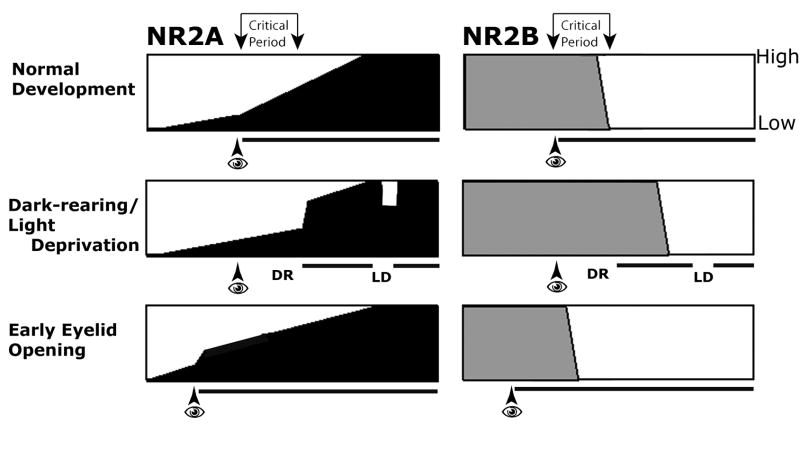Figure 7.
The normal development and the activity-dependent modulation of NR2A and NR2B subunits in layer IV of developing ferrets.
Row 1: In layer IV of ferret visual cortex, natural eye opening (eye symbol), which initiates patterned visual activity (black horizontal line), coincides with a surge of increase in prevalence of NR2A-containing synapses (darkly shaded areas in left panels) from low to high levels. In contrast, the prevalence NR2B-containing synapses (right panels) remains constant for the early post-eye opening ages, declining to low levels by P60.
Row 2: Dark-rearing (DR) until ages corresponding to the end of the critical period leads to a reduction in the prevalence of NR2A-containing synapses, which rapidly recovers to control levels by subsequent restoration of normal activity. A similar reduction occurs if the visual stimulation is removed in adulthood via light deprivation (LD). In contrast, the effect of visual deprivation and subsequent restoration of activity is a delay of NR2B downregulation that normally occurs concurrently with the decline of plasticity in layer IV.
Row 3. Early eyelid opening prematurely exposes animals to visual activity, and leads to an early upregulation of NR2A-containing synapses. This upregulation is a probably an early induction of NR2A in existing synapses, and does not push NR2A levels beyond normal in subsequent ages. Prematurely initiated vision may lead to an early downregulation of the ratio of NR2B containing synapses in layer IV. This effect is unique to layer IV, suggesting that early vision prematurely initiated a cascade of events that eventually leads to loss of NR2B from a unique population of synapses in this layer.

